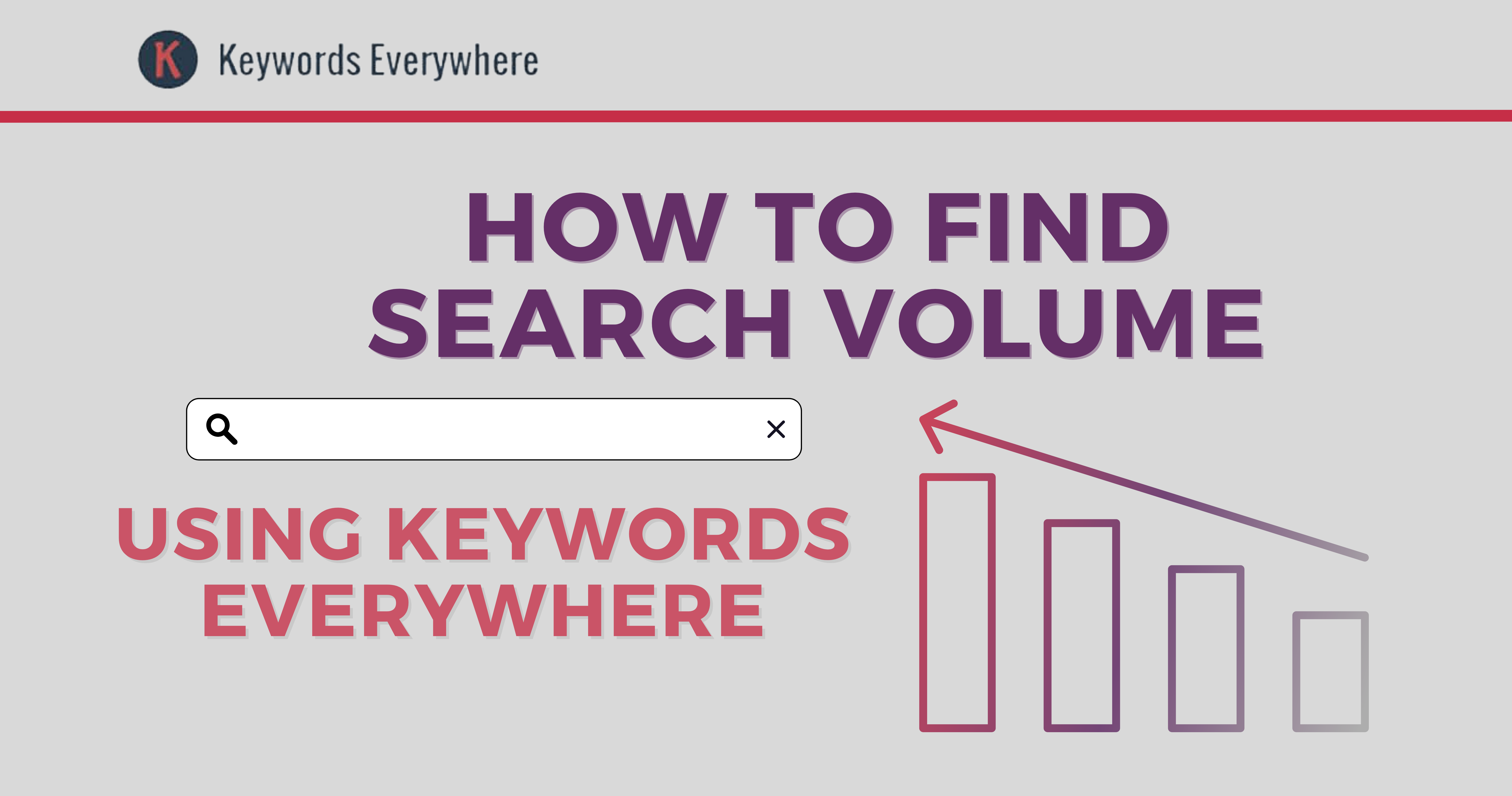Search volume is one of the key criteria marketers use to assess whether or not a keyword is worth targeting.
The higher the search volume, the more popular and productive the search term is. However, selecting a keyword with a good search volume and a doable level of competition is a balancing act.
In this article, let’s explore how you can easily find keyword search volume on the go and how you can analyze keyword search volume to develop a more successful SEO strategy.
What is Keyword Search Volume?
Search volume refers to the number of times a keyword is entered into a search engine such as Google over a given period of time– typically per month.
For example:
If you turn on our Keywords Everywhere extension and type into Google the term “keyword search volume”, you’ll immediately see that the exact search query is searched 6,600 times a month.

Our tool pulls data from Google Keyword Planner. Keep in mind that SEO tools showing search volume data are working with estimates and may show different search volumes for the same keyword.
Every keyword has a unique search volume– even two very similar keywords have different search volumes.
Looking into the exact search volume of your target keywords can help you better decide which search terms to prioritize in your content. This can guide your SEO strategy and help you evaluate potential organic traffic.
What is a Good Search Volume for a Keyword?
The exact number depends on your industry, your SEO goals, and the current state of your website. It’s not just about going for the keywords with high search volume. It’s also about choosing high-volume keywords that are not yet completely saturated by SEO competition.
For example:
The keyword ‘bag’ has a search volume of 110,000 per month, but you’ll also be competing against established sites and brands like Lacoste, Gucci, Kate Spade, and Coach– not to mention fashion e-magazines like Vogue and online marketplaces like Amazon.
While not impossible, it’ll be very hard for your website to reach the first page of Google for the term “bag”.

If you try to narrow down the search, you’ll find other potential keywords you can target like “artisan bag” with only 110 monthly search volume but with a lower SEO difficulty.

Depending on your product, you can keep on narrowing your search terms like blue bag, striped bag, hand bag for school, etc.
Using Keywords Everywhere, you can see a lot of widgets as you browse Google and other major platforms. You can discover more specific keyword ideas and see Related Keywords, People Also Search Keywords, and Long-tail Keywords (as shown below).
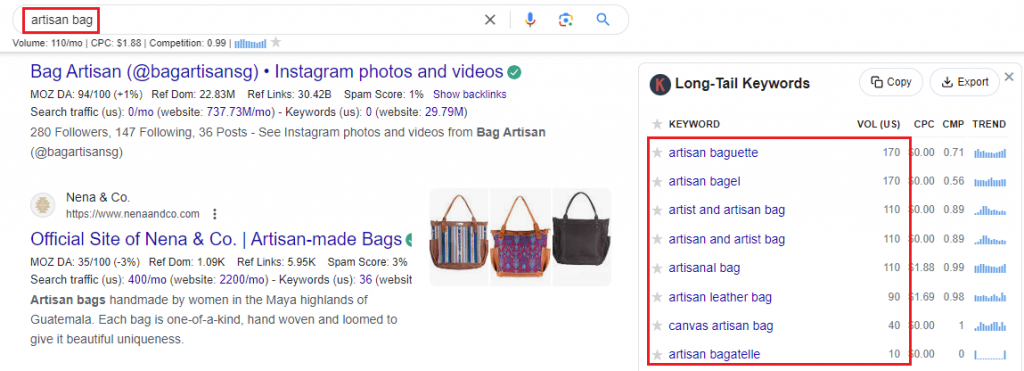
You don’t want too much competition, and you also don’t want to run the risk of pursuing keywords that no one is searching for. In general, 100-1000 searches per month is already a decent volume you can work around.
You can even consider targeting keywords with even less volume as statistics show that 95% of all keywords have a search volume of 10 or less per month.
To define a ‘good’ keyword, you need to look at many other factors besides search volume.
For example, the search intent and the value of a keyword to your business matter just as much. A transactional keyword with 100+ searches might be more lucrative for your business than an informational keyword with 1000+ search volume.
In the end, it depends on your goals and whether or not your website is ready to compete for broader terms.
Just keep that in mind as you strategize for SEO. You can make your keyword research process so much easier using our tool Keywords Everywhere.
How to Find Keyword Search Volume Using Keywords Everywhere
With Keywords Everywhere, you can easily find the right keywords with the right search volume. Just follow the steps below.
Step 1: Prepare Keywords List
Let’s use the same example above in the bag niche. If you sell bags, you can look at your collection and list down all potential keywords that match your products.
Consider all bag colors, textures, and sizes in your collection. You can even specify potential demographics like men, women, or kids or specify the specific styles that match your products.
Your list could look something like this:
- Leather bag for men
- White bag
- Blue school bag
- Leopard bag
- Fashion bag for kids
- Small tote bag
- Large crossbody bag
- Round rattan bag
- Beach bag
- old money bags
- Retro bags
- Summer style bags
- y2k bags
- Office hand bags
- Casual sling bags
On top of manually trying to come up with relevant keywords, you can also do competitor keyword research to add more to the list and check which keywords your competitors are ranking for.
Read: How to Find Competitor Keywords
Step 2: Open the Keywords Everywhere Extension
Open our Keywords Everywhere extension and make sure that it’s turned on. Then, click “Bulk Keywords Data”.
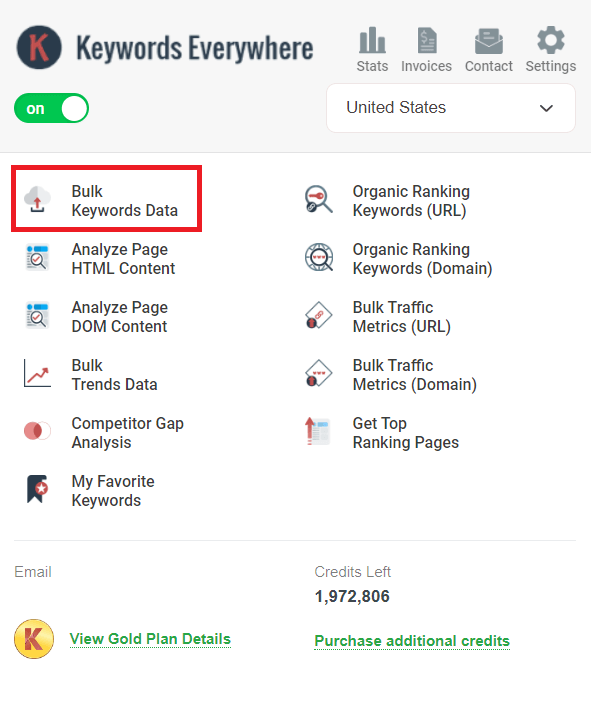
Step 3: Paste your list of keywords then click “Get Metrics”
You can enter up to 5000 keywords separated by comma, semicolon, or new line.
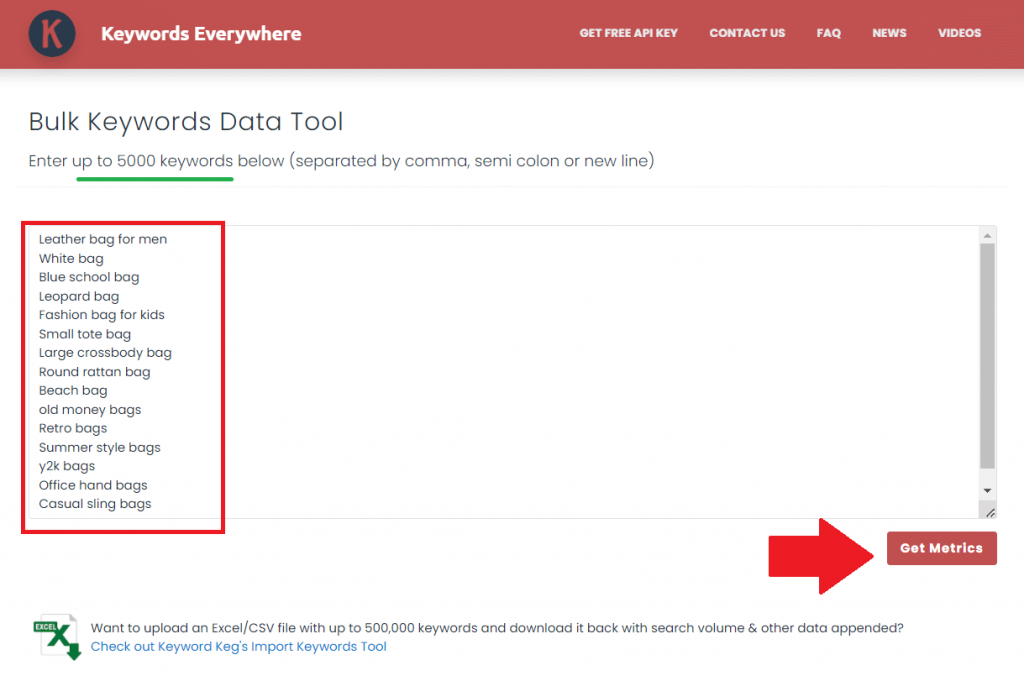
Step 4: Check, organize, and analyze the results
In just a few seconds, you will see the search volume of the keywords you pasted along with other SEO insights including CPC, Competition Score, and Trends.
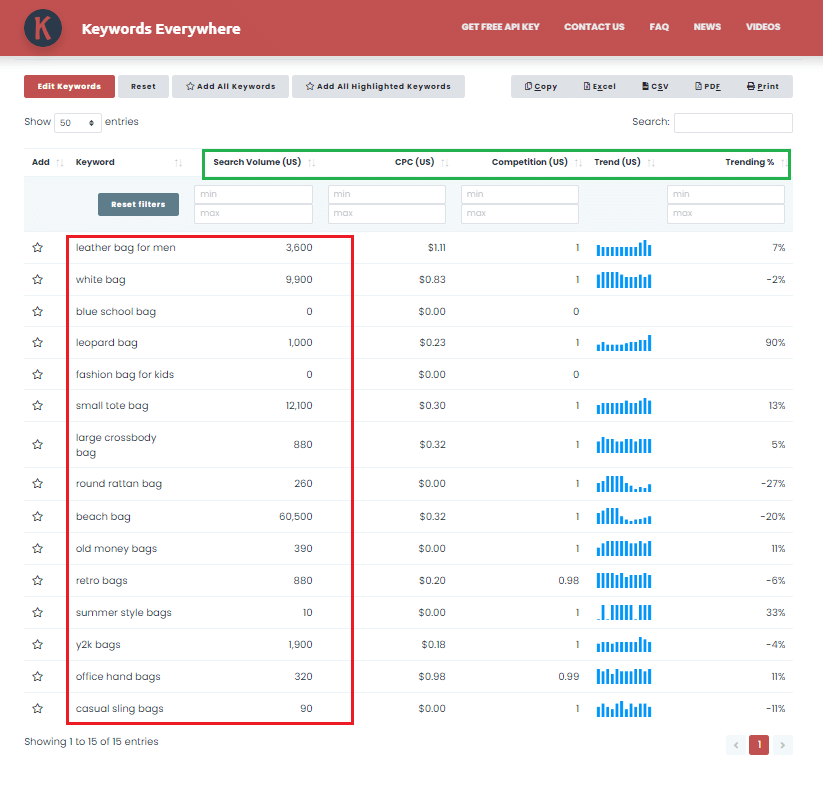
To organize the keywords, you can star the ones that you like and all the starred keywords will be saved to your My Favorite Keywords.
You can also just click ‘Copy” and then paste it onto a spreadsheet to slice and dice the information at a later time. You can export data, save the CSV or PDF copy, or print it directly.
Knowing the search volume of your target keywords can guide your content strategy. If you’re using Google Keyword Planner for keyword research, you can turn on our Keywords Everywhere extension, so you can see the search volume of the keyword ideas shown.
If you aren’t running any Google ads, the data you’ll get when using Google Keyword Planner will be very limited. Google only shows you the range for the search volume as shown below.
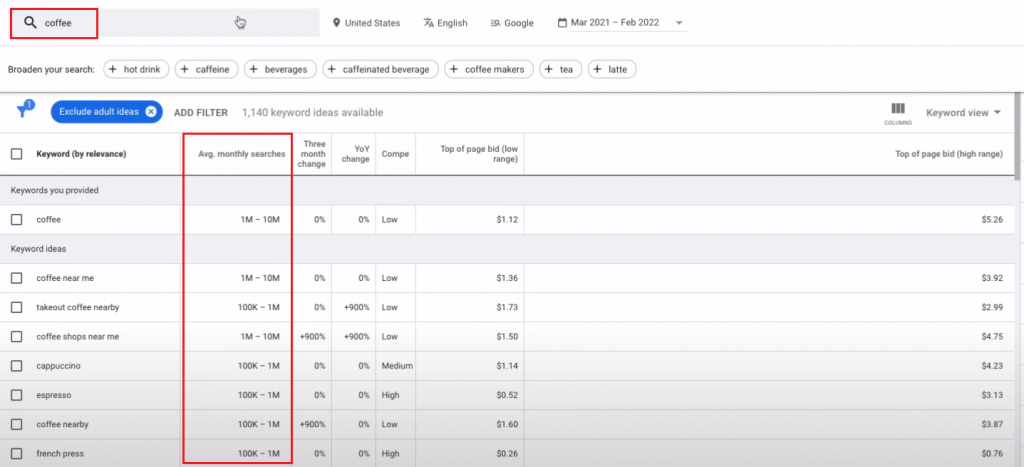
As you can see the search volume shown for the keyword coffee is 1M to 10M which is such a wide range.
To instantly see the specific search volume for the keyword ideas generated by Google Keyword Planner, just turn on the Keywords Everywhere extension and you’ll see the actual Search Volume, CPC, Competition Score, and Trend, which makes it super handy if you want to maximize keyword opportunities via Google Keyword Planner.
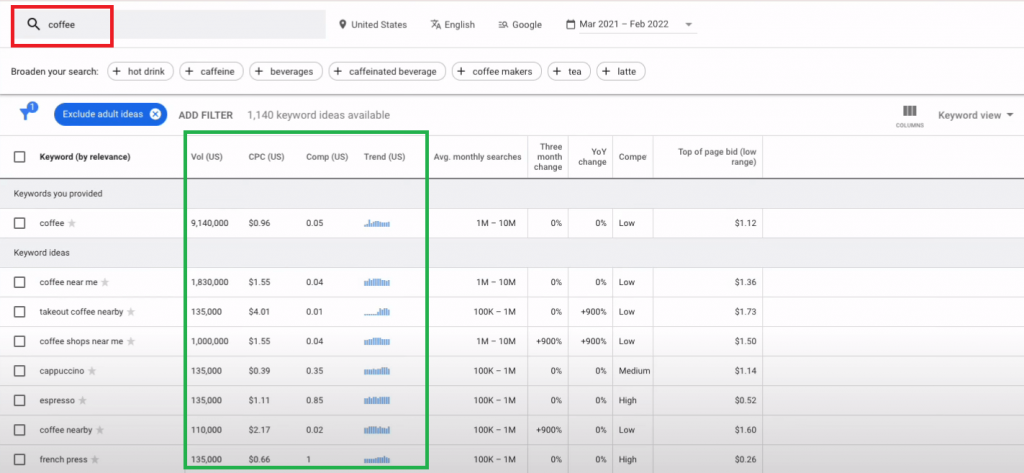
In the next few sections, we’ll further explore how to choose keywords by volume and how to rank for low-volume and high-volume keywords.
Types of Keywords Based on Length and Search Volume
Keywords can be a single word or longer phrases that help searchers find what they’re looking for. Understanding the types of keywords based on length and search volume can be a crucial part of your SEO strategy.
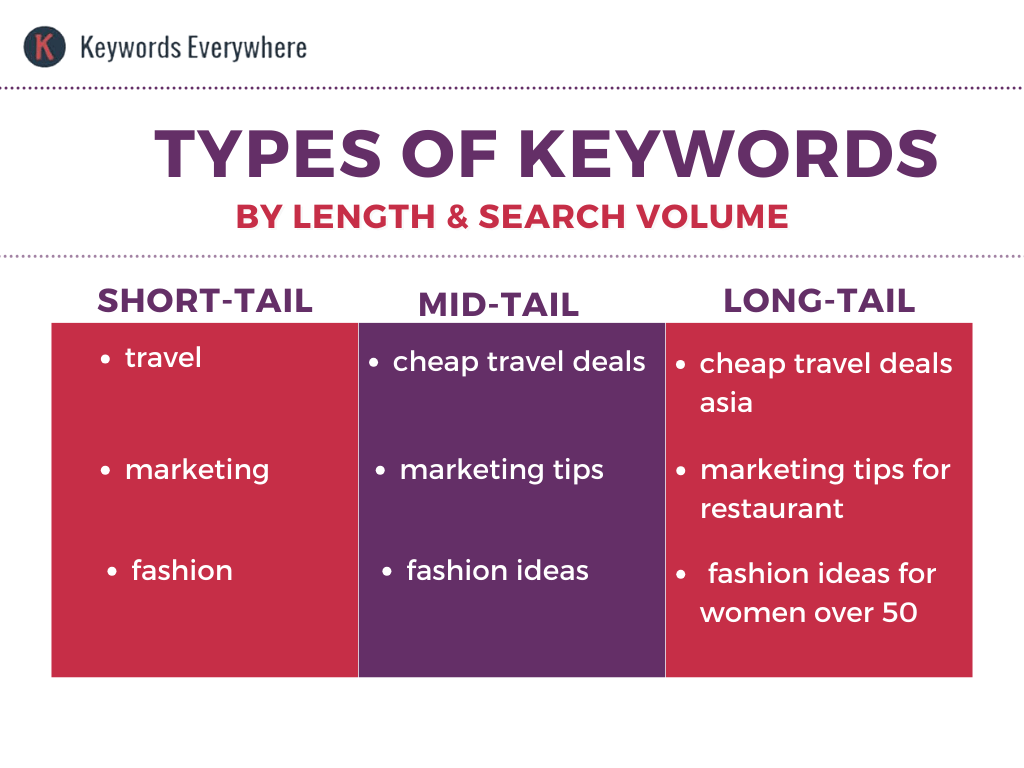
1. Short-tail Keywords
These are broad search terms with hundreds of thousands (or even millions) of searches like “travel”, “fashion”, or “marketing”.
In general, the shorter the keyword, the broader it is. Although these keywords can drive a lot of traffic, they’re also the hardest to rank for and not very targeted.
For example, if someone searches for ‘travel’ or ‘fashion’, it’s hard to identify the user’s intent. Is the searcher looking to learn or to transact? The other types of keywords, though more limited in search volume, can be used to target leads more effectively.
2. Mid-tail keywords
Mid-tail or medium-tail keywords usually have 2-3 words and a decent search volume. For example, ‘cheap travel deals’ or “fashion ideas”.
They have lower competition levels than broader terms, and their specificity can also help you attract target users to your offering.
3. Long-tail keywords
Although long-tail keywords have a lower search volume, they target very specific user intent. There usually are more modifiers, which indicates that the user has a clearer picture of what he/she is looking for and thus could be more ready to buy or convert.
About 70% of all web searchers are long-tail keywords, which is also associated with higher engagement.
Should You Target Low Search Volume Keywords?
Yes- especially if you have not established your domain authority yet. Newer sites can start with lower-volume keywords that are easier to rank for. That helps you slowly but surely establish more authority in your space and also attract backlinks in the process.
Once you gain more backlinks and establish your brand, you can start being more aggressive in targeting higher-volume keywords. Just make sure that the search terms you’re targeting are relevant to your business and your bottom line.
By being more realistic about your keyword selection process, you can focus your efforts where it matters and plant the seeds for long-term organic traffic and steady SEO growth.
Besides, long-tail keywords with lower search volume are generally used by people who are likely to convert because they already know what they want.
If a searcher types in “tote bags under 50”, even if the search volume is only around 110, the keyword’s intent and specificity can already increase the chances of conversion and engagement.

Also, keep in mind that accurate search volume is country-specific. People from different countries may search for the same keyword/ item differently.
For example, in the US, people may search for ‘fanny pack”, but in the UK, they call that small bag “bum bag”.
Open the Keywords Everywhere extension to set your target region accordingly:
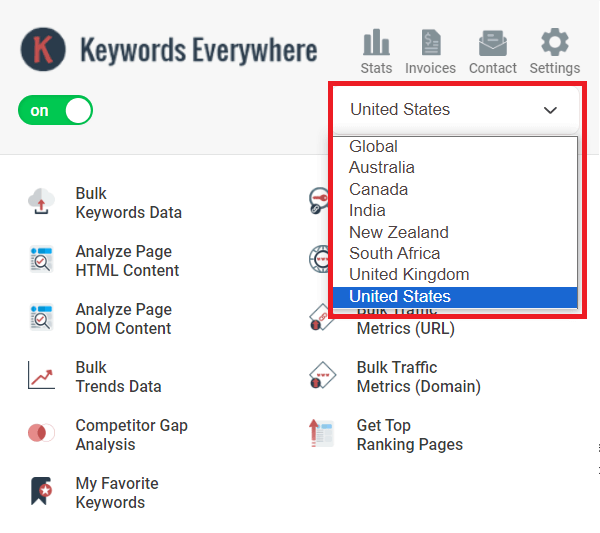
How to Rank for Keywords with High Search Volume
You may want to target keywords with high search volume to attract tons of traffic sooner rather than later. The thing is, regardless of the keyword’s volume and competitiveness, the goal is to create the type of content that is worthy of being on Google’s page one.
The clear-cut ways to win in SEO is to focus on the following:
1. Creating quality content
Focus on creating the best content you can develop– every time and all the time. Quality and relevance are the most important elements in terms of organic rankings.
Google’s function is to satisfy people’s queries, and if you’re helping Google achieve just that, you’ll definitely see growth and progress in no time.
2. On-page SEO
Proper on-page SEO helps search engines understand what your page is about. Make sure that the keyword is in the URL, page title, body, and meta description.
Use headers, images, visuals, and add internal and external links. Making the content attractive to both users and search engines is the way to go.
3. Build backlinks
SEO is still about backlinks, but it’s no longer a numbers game. The quality of backlinks matters more than quantity.
You can look into promoting your content and rolling out off-page SEO strategies including guest posting, video marketing, podcasting, influencer outreach, social media marketing, broken link building, press releases, and more.
To increase your chances of ranking well, whether or not the keyword has a high search volume, you need to focus on creating exceptional content and cover both on-page and off-page SEO.
You can also target a mix of high-volume and low-volume keywords to diversify your keyword approach and try capturing both immediate and long-term results.
Monitoring Keyword Performance and Optimizing Strategy
Staying on top of your site’s keyword positioning allows you to track your progress and also spot opportunities for keyword optimization.
If you notice a drop in keyword rankings, that could be a sign that something is wrong or needs optimization. It could be poor on-page SEO like errors with heading structure, pool internal linking, or lack of title and alt tags.
Recognizing high-performing and low-performing keywords allows you to know which pages to further optimize for better relevance and search engine visibility. It could also lead to other forms of improvement, be it in terms of user experience, site speed, mobile responsiveness, or simply a much-needed content update.
Keyword monitoring allows you to have a glimpse of what your competitors are up to or perhaps uncover new industry trends you can tap into.
Overall, it’s all about discerning whether or not your SEO efforts are paying off and making adjustments where it matters. SEO is an ongoing process, and constant re-evaluation and re-optimization can go a long way.
Conclusion
There’s no one-size-fits-all approach in SEO, so it requires experimenting with different strategies including selecting the right keyword volume to target.
You can target a mix of low or medium-difficulty keywords and focus on the highly relevant ones or those with good transactional intent. SEO is a long-term game, so you need to be patient and put in consistent effort to build that nice and steady long-term gain.

